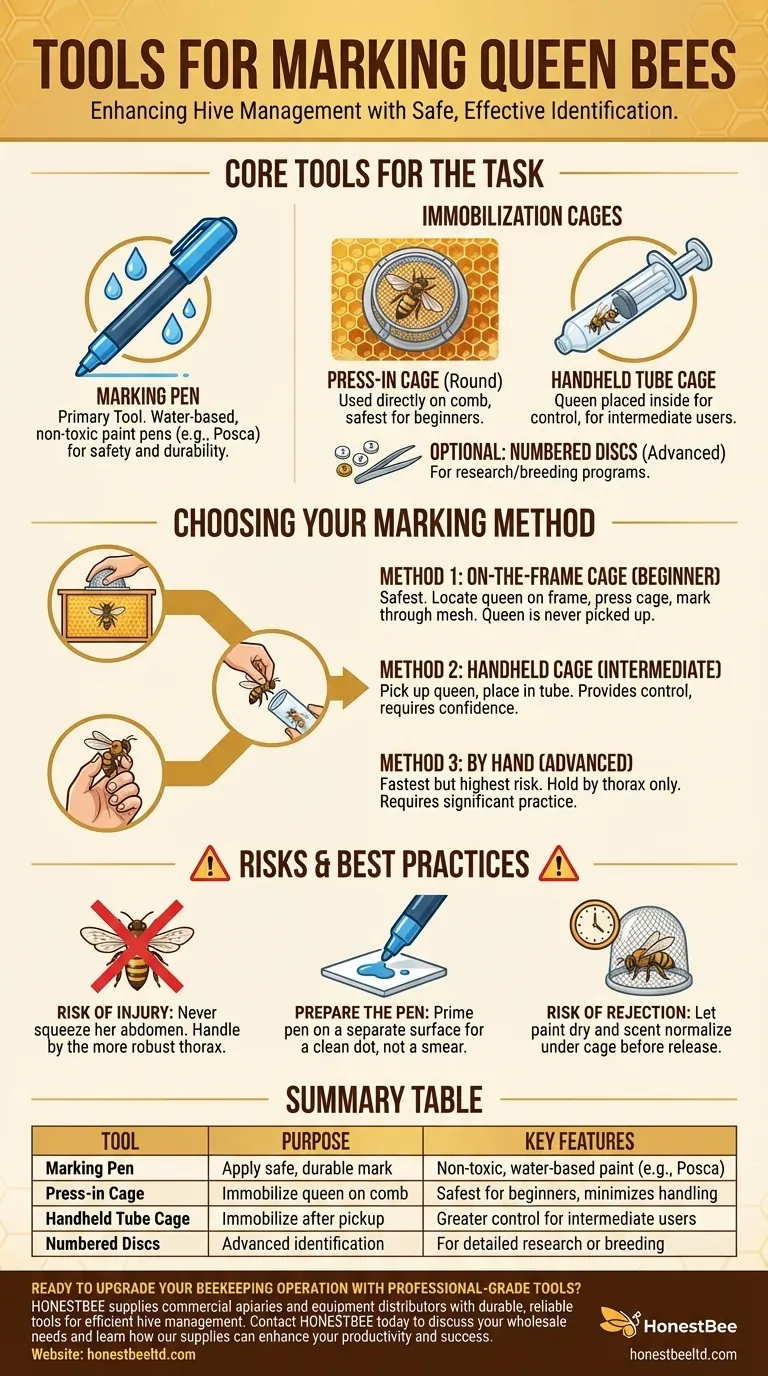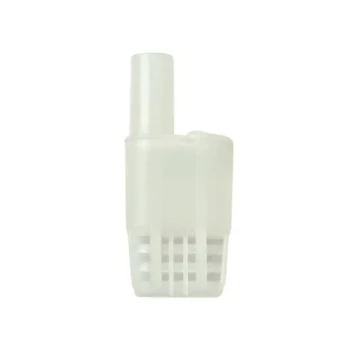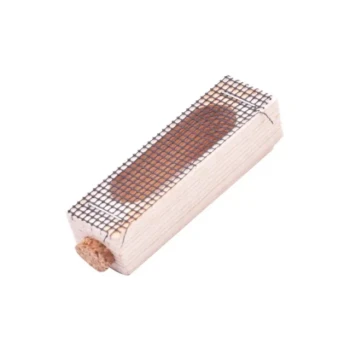To effectively mark a queen bee, beekeepers use a specific set of tools, most commonly non-toxic paint pens and specialized marking cages. These cages, which can be either press-in or handheld, are designed to gently immobilize the queen, allowing for a safe and accurate application of paint to her thorax.
Locating a single queen among 50,000 bees is a fundamental challenge in beekeeping. The solution is not just about the tool you use, but the method you employ to ensure the queen's safety, as a successful marking provides years of invaluable information for hive management.

Why Mark a Queen Bee?
Before choosing a tool, it's critical to understand the purpose. Marking a queen is a strategic decision that provides immediate, glanceable data about your colony.
Rapid Queen Identification
A marked queen can be spotted in seconds, saving significant time during hive inspections. This reduces the disruption to the colony and the stress on the beekeeper.
Confirming Her Presence
Finding the marked queen instantly confirms the hive is "queenright." If she is missing, you know immediately that the colony has either swarmed or is in the process of replacing her (supersedure).
Tracking Age and Lineage
A standardized international color code exists for marking queens by year. This allows you to track her age, evaluate her egg-laying performance over time, and make informed decisions about requeening.
Core Tools for the Task
While several tools exist, the process fundamentally requires two components: a way to mark and a way to safely restrain the queen.
The Marking Pen
Your primary tool is a marking pen. Water-based, non-toxic paint pens are the industry standard for safety and durability.
Brands like Posca are highly recommended because their paint is opaque, adheres well to the thorax, and lasts for the queen's entire lifespan without harming her.
The Immobilization Cage
You must immobilize the queen to apply a neat, safe mark. A cage prevents you from accidentally injuring her and ensures you only mark the top of her thorax.
There are two main types: a round press-in cage used directly on the comb and a one-handed tube cage that you place the queen inside of.
Optional: Numbered Discs
For more detailed research or large-scale breeding operations, small numbered discs can be glued to the queen's thorax. This is an advanced technique not typically required for most beekeepers.
Choosing Your Marking Method
The tool you choose is directly tied to the method you use to handle the queen. This choice depends entirely on your comfort level and experience.
Method 1: On-the-Frame Cage (Beginner)
This is the safest and least stressful method for a new beekeeper. You locate the queen on a frame of brood, gently press the cage over her, and then apply a dot of paint through the cage's mesh.
The queen is never picked up, minimizing the risk of dropping or injuring her.
Method 2: Handheld Cage (Intermediate)
This method involves picking the queen up by her wings or thorax and placing her in a one-handed marking tube. A soft foam plunger gently pushes her against a screen, exposing her thorax for marking.
This requires more confidence in handling the queen but provides excellent control.
Method 3: By Hand (Advanced)
The most experienced beekeepers often mark the queen by holding her between their thumb and forefinger. This is the fastest method but carries the highest risk.
You must hold her securely by the thorax without applying any pressure to her sensitive abdomen. This method should only be attempted after significant practice.
Understanding the Risks and Best Practices
Marking is a safe procedure when done correctly, but carelessness can have severe consequences for the colony.
The Risk of Injury
The queen's abdomen is fragile and contains her reproductive organs. Never squeeze her abdomen. Always handle her by the more robust thorax (the middle section of her body where the wings and legs attach).
Preparing the Marking Pen
Before you even touch the queen, prime your paint pen on a separate surface like your glove or a piece of wood. You want a small, ready bead of paint on the tip to ensure you can make a quick, clean dot rather than a messy smear.
The Risk of Rejection
In very rare instances, the colony may reject a queen if her scent is altered too much during the marking process. Leaving her under the press-in cage for a few minutes after marking allows the paint to dry and her scent to normalize before she moves freely among the bees.
Making the Right Choice for Your Goal
Your goal dictates your method. Choose the approach that matches your skill level and prioritizes the health of your queen.
- If your primary focus is safety and you are new to beekeeping: Use a press-in cage directly on the frame with a water-based paint pen.
- If your primary focus is control and you are comfortable handling bees: Use a one-handed marking tube after gently picking up the queen.
- If your primary focus is speed and you are a highly experienced beekeeper: Marking by hand is the most efficient option, but only if you have mastered the technique.
A simple, well-placed mark on your queen transforms hive inspections from a search into a confirmation.
Summary Table:
| Tool | Purpose | Key Features |
|---|---|---|
| Marking Pen | Apply a safe, durable mark | Non-toxic, water-based paint (e.g., Posca brand) |
| Press-in Cage | Immobilize queen on the comb | Safest for beginners, minimizes handling |
| Handheld Tube Cage | Immobilize queen after pickup | Offers greater control for intermediate users |
| Numbered Discs | Advanced identification | For detailed research or breeding programs |
Ready to upgrade your beekeeping operation with professional-grade tools?
HONESTBEE supplies commercial apiaries and beekeeping equipment distributors with the durable, reliable tools needed for efficient hive management. Our wholesale-focused operations ensure you get the quality equipment your business depends on, from marking pens to full hive systems.
Contact HONESTBEE today to discuss your wholesale needs and learn how our supplies can enhance your productivity and success.
Visual Guide

Related Products
- Queen Bee Marking Pen POSCA Queen Marking Pens for Beekeeping Bee Markers
- Queen Bee Marking Pen UNI Medium Point for Queen and Bee Marking
- Professional Engraved Round Hive Number Tags for Beekeeping
- Heavy Duty Stainless Steel Queen Bee Catcher Clip
- Plastic Queen Marking Tube Cage with Plunger for Beekeeping
People Also Ask
- What type of markers are commonly used for marking Queen bees? Choose the Safe, Non-Toxic Standard
- What are the benefits of marking a Queen bee for hive management? Boost Efficiency & Colony Health
- Where is the queen bee typically marked? A Guide to Safe & Effective Queen Identification
- What is the purpose of marking queen bees with colors? Essential for Hive Management & Efficiency
- What are the benefits of learning to mark your own queen bees? Boost Your Apiary's Efficiency and Confidence



















